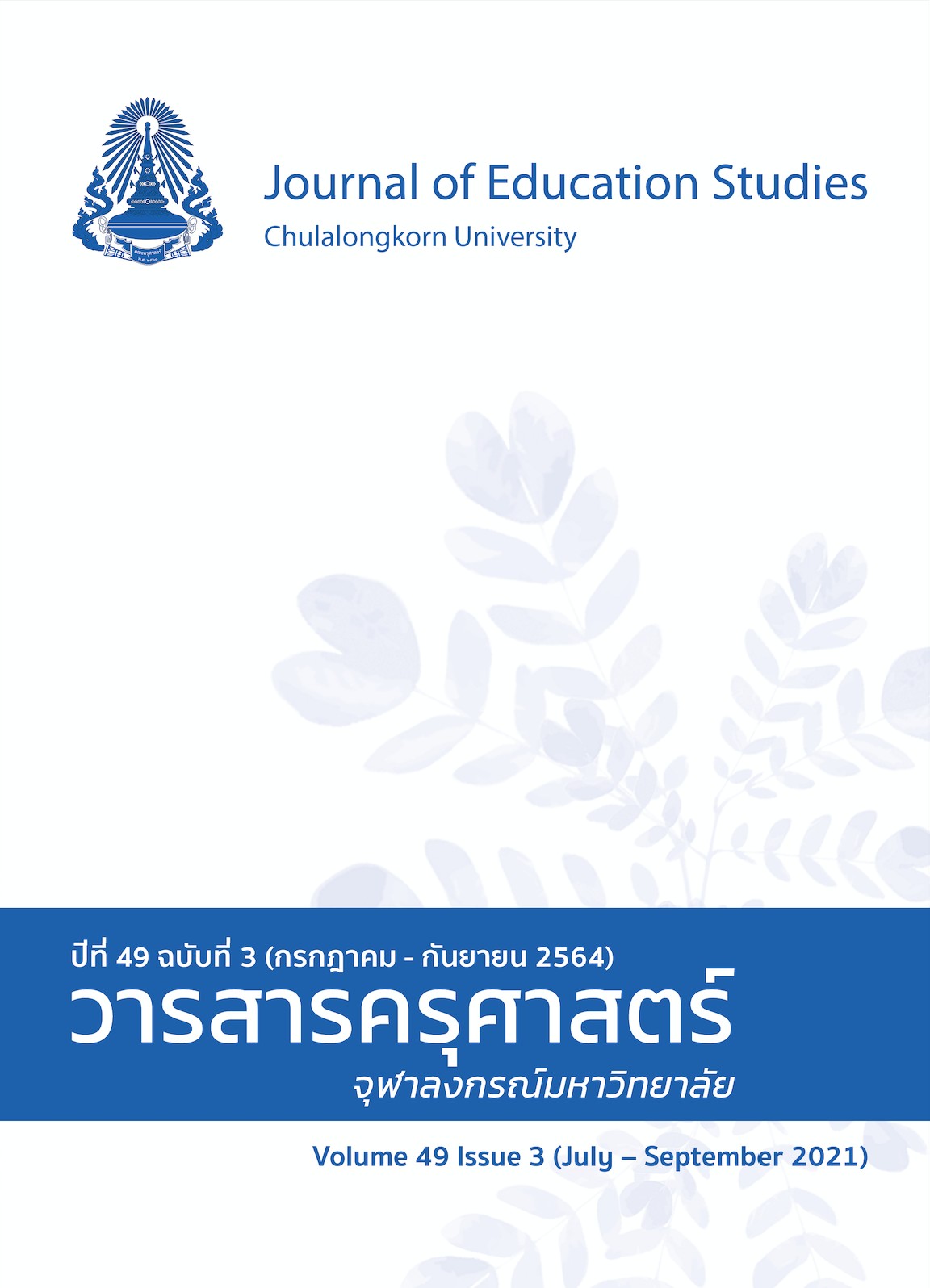Interaction between Interactive Computer-based Feedback Types and Physics Ability Levels on the Growth of Problem-Solving Abilities in Physics of Tenth Grade Students
DOI:
https://doi.org/10.14456/educu.2021.40Keywords:
interaction, interactive feedback, physics ability, problem solving abilityAbstract
The purposes of this study were 1) to study the interactions between interactive computer-based feedback types (fade-out, fade-in, constant, and knowledge of correct response feedback) and physics ability levels (high, moderate, and low) on the growth of physics-based problem-solving abilities of students, and 2) to compare the growth of physics-based problem-solving abilities of students who received four different types of interactive computer-based feedback. The sample consisted of 73 tenth grade students. The research instruments were physics-based problem-solving ability exercises delivered via computer systems and physics-based problem-solving ability tests. Quantitative data were analyzed by using descriptive statistics, relative gain scores, repeated measures ANOVA, and two-way ANOVA. Results revealed that 1) there was an interaction between interactive computer-based feedback types and physics ability levels on the growth of physics-based problem-solving abilities of students at the statistically significant level of .05, and 2) students in the high ability level who received different interactive computer-based feedback types did not differ in the development of problem-solving abilities at the statistically significant level of .05. Students in the moderate ability level, who received fade-out feedback and constant feedback, as well as students in the low ability level, who received constant feedback were better in developing problem-solving abilities than those who received knowledge of correct response feedback at the statistically significant level of .05
References
กระทรวงศึกษาธิการ. สำนักงานคณะกรรมการการศึกษาขั้นพื้นฐาน. (2557). แนวทางปฏิบัติการวัดและประเมินผลการเรียนรู้ตามหลักสูตรแกนกลางการศึกษาขั้นพื้นฐาน พุทธศักราช 2551 (พิมพ์ครั้งที่ 4). ชุมนุมสหกรณ์การเกษตรแห่งประเทศไทย.
กิตติทัศน์ หวานฉ่ำ. (2560). ผลของประเภทข้อมูลย้อนกลับและการเปลี่ยนคำตอบที่มีต่อผลสัมฤทธิ์ทางการเรียน คะแนนที่เพิ่มขึ้น และความสามารถในการแก้โจทย์ปัญหาฟิสิกส์ของนักเรียนชั้นมัธยมศึกษาปีที่ 4 [วิทยานิพนธ์ปริญญามหาบัณฑิต]. Chulalongkorn University Intellectual Repository (CUIR). http://cuir.car.chula.ac.th/
handle/123456789/59861
เกริก ศักดิ์สุภาพ. (2561). ผลการจัดกิจกรรมการเรียนรู้แบบ PECA ร่วมกับโปรแกรมควิปเปอร์ สคูล เพื่อส่งเสริมความสามารถในการแก้โจทย์ปัญหาฟิสิกส์ของนักเรียนระดับชั้นมัธยมศึกษาปีที่ 4. วารสารศึกษาศาสตร์ มหาวิทยาลัยนเรศวร, 20(2), 12-20. https://so06.tcithaijo.org/index.php/edujournal_nu/article/view/62063
โชติกา ภาษีผล. (2559). การวัดและประเมินผลการเรียนรู้. จุฬาลงกรณ์มหาวิทยาลัย.
นิพนธ์ นิลคง. (2541). ความสัมพันธ์ระหว่างความสามารถในการคิดหาเหตุผลเชิงตรรกศาสตร์ ทักษะการคำนวณในการเรียนวิชาฟิสิกส์และความสามารถในการแก้โจทย์ปัญหาฟิสิกส์ของนักเรียนระดับมัธยมศึกษาตอนปลาย กรุงเทพมหานคร [วิทยานิพนธ์ปริญญามหาบัณฑิต]. Chulalongkorn University Intellectual Repository (CUIR).
http://cuir.car.chula.ac.th/handle/123456789/10336
รักษพล ธนานุวงศ์. (2558). สอนเพื่อทำข้อสอบ หรือ สอบก่อนแล้วค่อยทำข้อสอบ. นิตยสาร สสวท., 43(194), 40-44. https://library.ipst.ac.th/bitstream/handle/ipst/340/194.pdf
ศักดิ์ศรี ปาณะกุล, นิรมล ศตวุฒิ, และ ระวิวรรณ ศรีคร้ามครัน. (2562). หลักสูตรและการจัดการเรียนรู้ (พิมพ์ครั้งที่ 5). มหาวิทยาลัยรามคำแหง.
ศิริชัย กาญจนวาสี. (2556). ทฤษฎีการทดสอบแบบดั้งเดิม (พิมพ์ครั้งที่ 7). จุฬาลงกรณ์มหาวิทยาลัย.
สถาบันส่งเสริมการสอนวิทยาศาสตร์และเทคโนโลยี สาขาฟิสิกส์. (2554). สอนฟิสิกส์อย่างไร ให้ผู้เรียนเข้าใจจริง. นิตยสาร สสวท., 39(172), 40-43. https://library.ipst.ac.th/bitstream/handle/ipst/318/172_ฉบับเต็ม.pdf
สุรางค์ โค้วตระกูล. (2556). จิตวิทยาการศึกษา (พิมพ์ครั้งที่ 11). จุฬาลงกรณ์มหาวิทยาลัย.
สุวรัตน์ ทองพันชั่ง. (2560). ผลของรูปแบบการให้ข้อมูลย้อนกลับแบบผสมที่แตกต่างกันด้วยคอมพิวเตอร์ที่มีต่อพัฒนาการความสามารถด้านคำนวณของนักเรียนมัธยมศึกษาตอนต้น [วิทยานิพนธ์ปริญญามหาบัณฑิต]. Chulalongkorn University Intellectual Repository (CUIR). http://cuir.car.chula.ac.th/handle/123456789/58440
อนงค์ พิทักษ์เมธีธรรม. (2555). ผลของรูปแบบการให้ข้อมูลย้อนกลับที่แตกต่างกันที่มีต่อความสามารถในการแก้ปัญหาทางคณิตศาสตร์ของนักเรียนระดับมัธยมศึกษาปีที่ 1 [วิทยานิพนธ์ปริญญามหาบัณฑิต]. Chulalongkorn University Intellectual Repository (CUIR). http://cuir.car.chula.ac.th/handle/123456789/45304
ภาษาอังกฤษ
Atkinson, R. K., & Renkl, A. (2007). Interactive example-based learning environments: using interactive elements to encourage effective processing of worked examples. Educational Psychology Review, 19(3), 375-386. https://doi.org/10.1007/s10648-007- 9055-2
Çalişkan, S., Selçuk, G. S., & Erol, M. (2010). Instruction of problem solving strategies: Effects on physics achievement and self-efficacy beliefs. Journal of Baltic Science Education, 9(1), 20-34. http://www.scientiasocialis.lt/jbse/files/pdf/vol9/2034.Caliskan_Vol.9_No.1.pdf
Corbalan, G., Paas, F., & Cuypers, H. (2010). Computer-based feedback in linear algebra: Effects on transfer performance and motivation. Computers & Education, 55(2), 692-703. https://doi.org/10.1016/j.compedu.2010.03.002
Finn, B., Thomas, R., & Rawson, K. A. (2018). Learning more from feedback: Elaborating feedback with examples enhances concept learning. Learning and Instruction, 54, 104-113. https://doi.org/10.1016/j.learninstruc.2017.08.007
Hattie, J., & Timperley, H. (2007). The power of feedback. Review of Educational Research, 77(1), 81-112. https://doi.org/10.3102/003465430298487
Heller, K., & Heller, P. (2010). Cooperative problem solving in physics a user’s manual. https://www.aapt.org/Conferences/newfaculty/upload/Coop-Problem-Solving-Book.pdf
Hollabaugh, M. (1995). Physics problem solving in cooperative learning groups [Doctoral dissertation]. University of Minnesota Physics Education Research and Development. https://groups.spa.umn.edu/physed/People/
Hollabaugh%20Dissertation.pdf
Jennings, J., & Muldner, K. (2020). Assistance that fades in improves learning better than assistance that fades out. Instructional Science, 48(2020), 371-394. https://doi.org/10.1007/s11251-020-09520-7
Mason, B. J., & Bruning, R. H. (2001). Providing feedback in computer-based instruction: What the research tells us. http://dwb.unl.edu/Edit/MB/
MasonBruning.html
Renkl, A., & Atkinson, R. K. (2010). Learning from worked-out examples and problem solving. In J. L. Plass, R. Moreno, & R. Brünken (Eds.), Cognitive load theory (pp. 91-108). Cambridge University Press. https://doi.org/10.1017/cbo
9780511844744.007
Serway, R. A., & Jewett, J. W., Jr. (2019). Physics for scientists and engineers with modern physics (10th ed.). Cengage.
Shute, V. J. (2008). Focus on formative feedback. Review of Educational Research, 78(1). https://doi.org/10.3102/0034654307313795
Sweller, J., & Cooper, G. A. (1985). The use of worked examples as a substitute for problem solving in learning algebra. Cognition and Instruction, 2(1), 59-89. https://doi.org/10.1207/s1532690xci0201_3
van der Kleij, F. M., Feskens, R. C. W., & Eggen, T. J. H. M. (2015). Effects of feedback in a computer-based learning environment on students’ learning outcomes. Review of Educational Research, 85(4), 475-511. https://doi.org/10.3102/0034654314564881
Downloads
Published
How to Cite
Issue
Section
License

This work is licensed under a Creative Commons Attribution-NonCommercial-NoDerivatives 4.0 International License.




